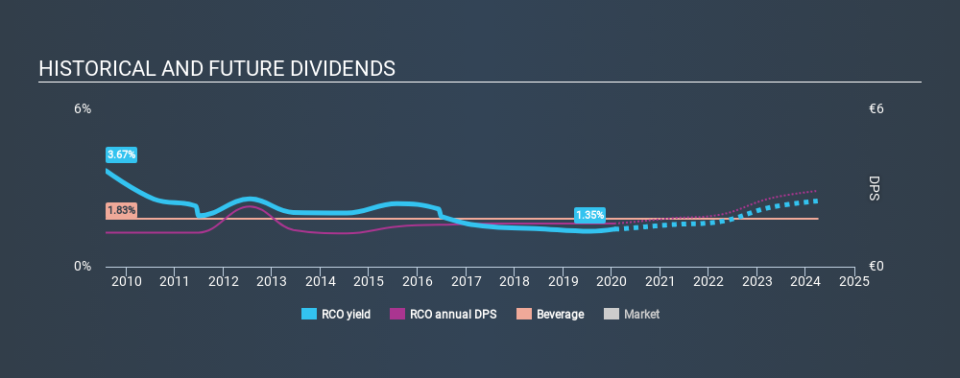Here's What You Should Know About Rémy Cointreau SA's (EPA:RCO) 1.4% Dividend Yield

Dividend paying stocks like Rémy Cointreau SA (EPA:RCO) tend to be popular with investors, and for good reason - some research suggests a significant amount of all stock market returns come from reinvested dividends. If you are hoping to live on the income from dividends, it's important to be a lot more stringent with your investments than the average punter.
A 1.4% yield is nothing to get excited about, but investors probably think the long payment history suggests Rémy Cointreau has some staying power. The company also bought back stock during the year, equivalent to approximately 1.8% of the company's market capitalisation at the time. There are a few simple ways to reduce the risks of buying Rémy Cointreau for its dividend, and we'll go through these below.
Explore this interactive chart for our latest analysis on Rémy Cointreau!
Payout ratios
Companies (usually) pay dividends out of their earnings. If a company is paying more than it earns, the dividend might have to be cut. Comparing dividend payments to a company's net profit after tax is a simple way of reality-checking whether a dividend is sustainable. In the last year, Rémy Cointreau paid out 53% of its profit as dividends. This is a healthy payout ratio, and while it does limit the amount of earnings that can be reinvested in the business, there is also some room to lift the payout ratio over time.
Another important check we do is to see if the free cash flow generated is sufficient to pay the dividend. The company paid out 72% of its free cash flow, which is not bad per se, but does start to limit the amount of cash Rémy Cointreau has available to meet other needs. It's positive to see that Rémy Cointreau's dividend is covered by both profits and cash flow, since this is generally a sign that the dividend is sustainable, and a lower payout ratio usually suggests a greater margin of safety before the dividend gets cut.
We update our data on Rémy Cointreau every 24 hours, so you can always get our latest analysis of its financial health, here.
Dividend Volatility
From the perspective of an income investor who wants to earn dividends for many years, there is not much point buying a stock if its dividend is regularly cut or is not reliable. For the purpose of this article, we only scrutinise the last decade of Rémy Cointreau's dividend payments. Its dividend payments have declined on at least one occasion over the past ten years. During the past ten-year period, the first annual payment was €1.30 in 2010, compared to €1.65 last year. This works out to be a compound annual growth rate (CAGR) of approximately 2.4% a year over that time. Rémy Cointreau's dividend payments have fluctuated, so it hasn't grown 2.4% every year, but the CAGR is a useful rule of thumb for approximating the historical growth.
We're glad to see the dividend has risen, but with a limited rate of growth and fluctuations in the payments, we don't think this is an attractive combination.
Dividend Growth Potential
Given that the dividend has been cut in the past, we need to check if earnings are growing and if that might lead to stronger dividends in the future. It's good to see Rémy Cointreau has been growing its earnings per share at 20% a year over the past five years. Rémy Cointreau's earnings per share have grown rapidly in recent years, although more than half of its profits are being paid out as dividends, which makes us wonder if the company has a limited number of reinvestment opportunities in its business.
Conclusion
To summarise, shareholders should always check that Rémy Cointreau's dividends are affordable, that its dividend payments are relatively stable, and that it has decent prospects for growing its earnings and dividend. First, we think Rémy Cointreau is paying out an acceptable percentage of its cashflow and profit. We were also glad to see it growing earnings, but it was concerning to see the dividend has been cut at least once in the past. In sum, we find it hard to get excited about Rémy Cointreau from a dividend perspective. It's not that we think it's a bad business; just that there are other companies that perform better on these criteria.
Companies that are growing earnings tend to be the best dividend stocks over the long term. See what the 17 analysts we track are forecasting for Rémy Cointreau for free with public analyst estimates for the company.
If you are a dividend investor, you might also want to look at our curated list of dividend stocks yielding above 3%.
If you spot an error that warrants correction, please contact the editor at editorial-team@simplywallst.com. This article by Simply Wall St is general in nature. It does not constitute a recommendation to buy or sell any stock, and does not take account of your objectives, or your financial situation. Simply Wall St has no position in the stocks mentioned.
We aim to bring you long-term focused research analysis driven by fundamental data. Note that our analysis may not factor in the latest price-sensitive company announcements or qualitative material. Thank you for reading.



